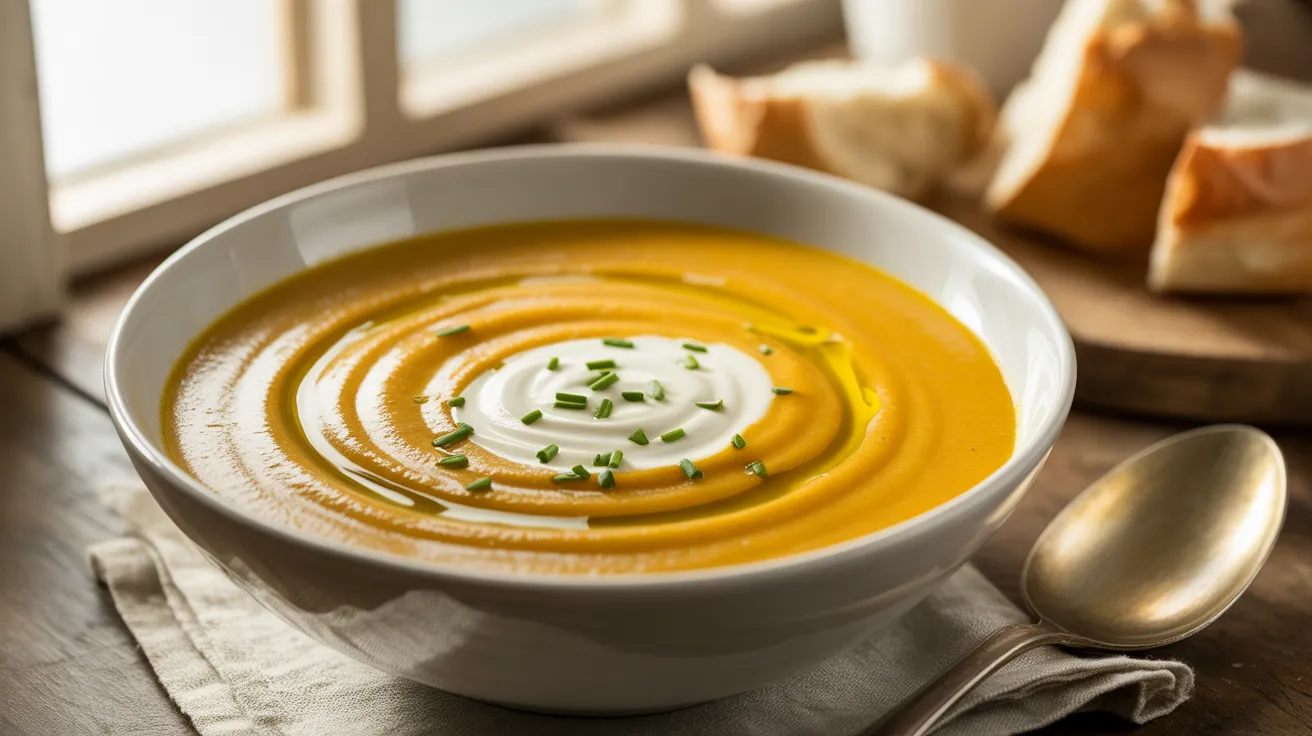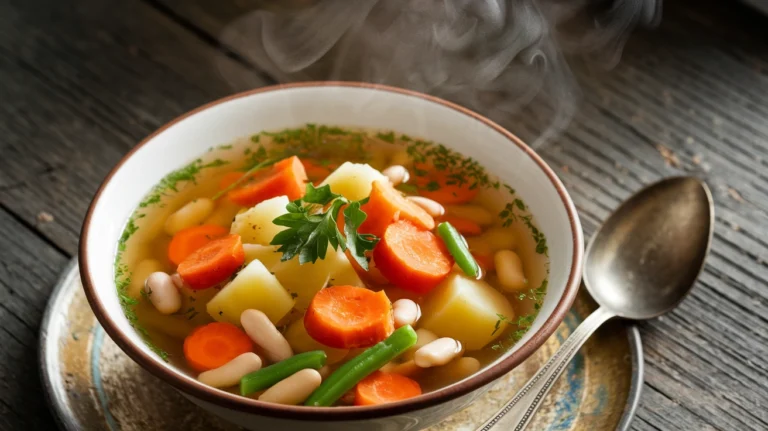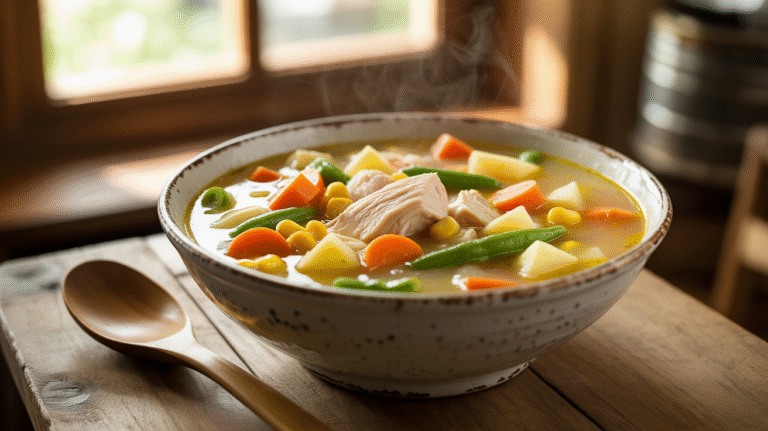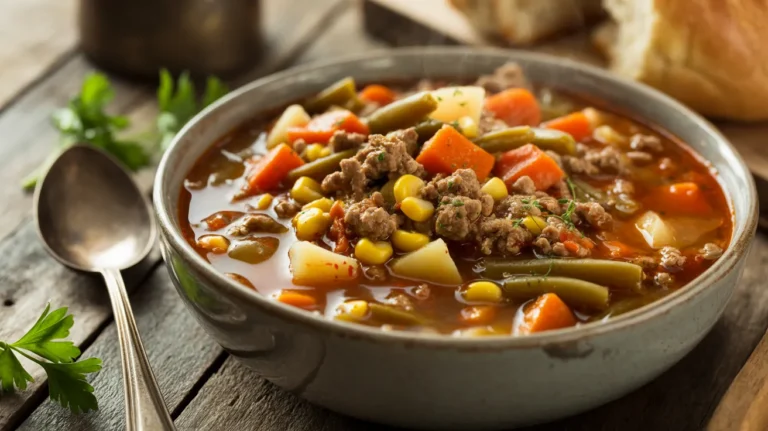This Potage aux Legumes Creamy Vegetable Soup brings French comfort to your table with silky-smooth texture and garden-fresh flavor. Whether you’re craving a cozy dinner or an elegant starter, this Potage aux Legumes recipe transforms simple vegetables into restaurant-quality soup in under an hour.
SERVES: 4 | PREP: 15 MIN | COOK: 35 MIN | TOTAL: 50 MIN
Ingredients
Base Vegetables
| Ingredient | Amount |
|---|---|
| Leeks (white and light green parts only) | 2 medium, sliced |
| Carrots | 3 medium, peeled and chopped |
| Celery stalks | 2, chopped |
| Yukon Gold potatoes | 2 medium, peeled and cubed |
| Yellow onion | 1 large, diced |
| Garlic cloves | 4, minced |
Liquids & Dairy
| Ingredient | Amount |
|---|---|
| Vegetable broth (low-sodium) | 5 cups |
| Heavy cream | ¾ cup |
| Whole milk | ½ cup |
| Dry white wine | ¼ cup (optional) |
Seasonings & Fats
| Ingredient | Amount |
|---|---|
| Unsalted butter | 3 tablespoons |
| Fresh thyme sprigs | 4 |
| Bay leaf | 1 |
| Sea salt | 1½ teaspoons |
| White pepper | ½ teaspoon |
| Nutmeg (freshly grated) | ¼ teaspoon |
Garnish
| Ingredient | Amount |
|---|---|
| Fresh chives | 2 tablespoons, chopped |
| Crème fraîche | 4 tablespoons |
| Extra virgin olive oil | Drizzle |
Step-by-Step Instructions
Phase 1: Vegetable Preparation (10 minutes)
Step 1: Prep your leeks properly. Slice the leeks lengthwise and rinse under cold running water, separating the layers to remove any hidden dirt. Leeks trap sand between layers, so this step prevents gritty soup. Pat them completely dry with paper towels before slicing into ½-inch pieces.
Step 2: Cut vegetables uniformly. Chop all vegetables into roughly 1-inch pieces for even cooking. Uniform size means everything becomes tender at the same time, preventing some pieces from being mushy while others stay hard. This is your foundation for smooth, creamy soup.
Step 3: Organize your mise en place. Place your chopped vegetables in separate bowls near your stovetop. Having everything ready before you start cooking prevents burning and allows you to focus on timing. Set your broth and cream nearby too.
Phase 2: Building Flavor Base (8 minutes)
Step 4: Melt butter over medium heat. Add 3 tablespoons butter to your heavy-bottomed pot or Dutch oven. Wait until it stops foaming and smells slightly nutty—this takes about 1 minute. This indicates the water has evaporated, concentrating the butter’s flavor.
Step 5: Sweat the aromatics. Add your diced onions and sliced leeks to the melted butter. Cook for 5 minutes, stirring every 30 seconds, until they turn translucent but not brown. Translucent means the cell walls have broken down, releasing natural sugars without caramelization. If they start browning, reduce your heat immediately.
Step 6: Add garlic at the right moment. Stir in your minced garlic and cook for just 45 seconds. Garlic burns quickly and turns bitter, so adding it after the onions prevents this. You’ll smell a fragrant aroma when it’s ready—that’s your cue to move on.
Step 7: Deglaze with wine (optional). Pour in the white wine if using, scraping up any brown bits stuck to the pot bottom with a wooden spoon. Let it bubble for 2 minutes until reduced by half. The alcohol cooks off, leaving behind bright acidity that balances the cream later.
Phase 3: Cooking the Vegetables (25 minutes)
Step 8: Add hardy vegetables first. Toss in your chopped carrots, celery, and cubed potatoes. Stir to coat them with the butter mixture for 2 minutes. This step seasons the vegetables from the inside out before liquid is added.
Step 9: Pour in your broth. Add all 5 cups vegetable broth, along with the thyme sprigs and bay leaf. Bring the mixture to a rolling boil over high heat—this should take about 5 minutes. A rolling boil means large bubbles breaking the surface constantly.
Step 10: Reduce to gentle simmer. Once boiling, immediately reduce heat to medium-low until you see small bubbles occasionally breaking the surface. Gentle simmering prevents vegetables from breaking apart before they’re fully tender. Cover the pot halfway—full covering traps too much steam and makes the soup watery.
Step 11: Cook until fork-tender. Let everything simmer for 20-25 minutes. Test by piercing a potato cube with a fork—it should slide in with zero resistance. If there’s any firmness, cook 5 minutes longer. Undercooked vegetables create a grainy texture when blended.
Step 12: Remove herbs. Fish out the thyme sprigs and bay leaf with tongs or a slotted spoon. Leaving them in will create woody bits in your smooth soup. Count your thyme sprigs going in so you know how many to remove.
Phase 4: Blending & Finishing (7 minutes)
Step 13: Cool slightly before blending. Let the soup sit off the heat for 3-4 minutes. Hot liquid expands when blended and can explode out of your blender, causing burns. This brief cooling makes blending safer while keeping the soup warm enough to serve.
Step 14: Blend in batches. Working in 2-cup portions, fill your blender only halfway and hold the lid down with a folded kitchen towel. Blend on low speed for 10 seconds, then increase to high for 30-40 seconds until completely smooth. Never fill the blender more than halfway with hot liquid. Pour each blended batch into a clean pot.
Step 15: Add cream and milk. Stir in the heavy cream and whole milk over low heat. Don’t let it boil after adding dairy, or the proteins will curdle and create an unpleasant grainy texture. Heat gently for 3-4 minutes, stirring occasionally, until steaming but not bubbling.
Step 16: Season to perfection. Add salt, white pepper, and freshly grated nutmeg. Taste and adjust—the soup should taste vibrant, not flat. Start with listed amounts, then add more salt ¼ teaspoon at a time until the flavors pop. The nutmeg should be barely detectable, just adding warmth.
Chef’s Notes
Potato choice matters. Yukon Golds create the creamiest Potage aux Legumes because their medium starch content blends silky-smooth without becoming gluey like russets. Waxy red potatoes work in a pinch but yield a thinner consistency.
Immersion blender shortcut. While a countertop blender creates the silkiest texture, you can use an immersion blender directly in the pot for convenience. Blend for 2-3 minutes, moving constantly, to break down every vegetable fiber.
White pepper keeps it elegant. Traditional Potage aux Legumes Creamy Vegetable Soup uses white pepper instead of black to maintain the soup’s pristine cream color. If using black pepper, expect visible specks—still delicious, just less refined in appearance.
Wine alternatives. Skip the wine? Add 2 tablespoons fresh lemon juice with the broth instead. This bright acidity prevents the cream from tasting heavy and flat.
Nutrition Information (Per Serving)
Calories: 285
Protein: 6g
Carbohydrates: 31g
Fat: 16g
Fiber: 5g
Sodium: 620mg
Creative Variations
Root Vegetable Twist. Swap half the potatoes for parsnips and add a small turnip for earthy sweetness. This variation pairs beautifully with roasted autumn vegetables for a seasonal menu.
Herbed Green Version. Add 2 cups fresh spinach and 1 cup frozen peas during the last 5 minutes of cooking. Blend in ½ cup fresh basil leaves for a vibrant green soup that looks stunning in white bowls.
Cheesy Indulgence. Stir in ½ cup grated Gruyère cheese after blending for authentic French flair. The cheese melts into silky strands and adds nutty depth without overwhelming the vegetables.
One-Pot Wonder. Looking for more easy soups? Try this creamy vegetable soup that uses similar techniques but cooks even faster for busy weeknights.
Storage & Reheating Guide
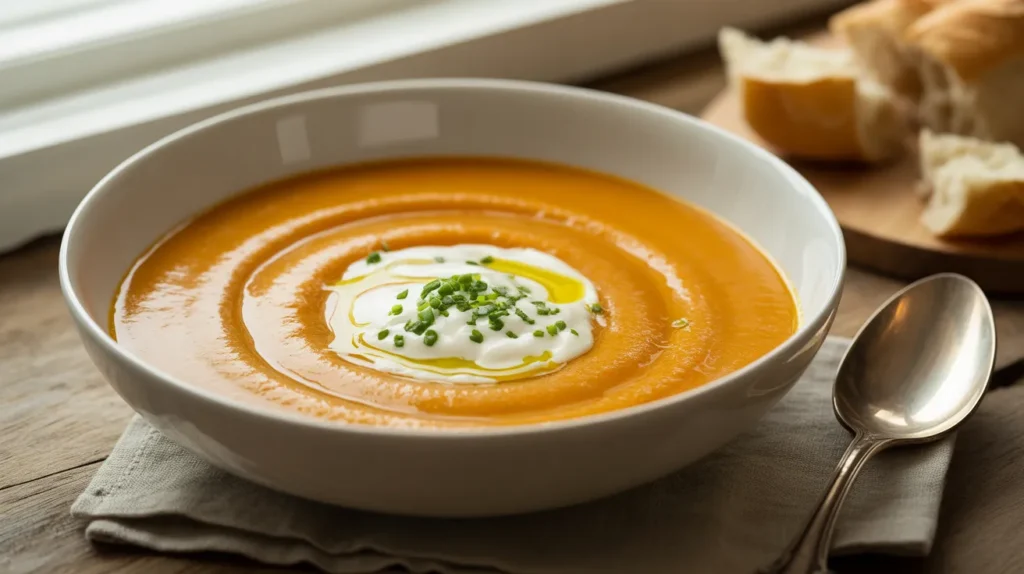
Refrigerator storage. Pour cooled soup into airtight containers within 2 hours of cooking. Store for up to 5 days in the refrigerator. The flavors actually improve overnight as everything melds together.
Freezing instructions. Freeze in 2-cup portions in freezer-safe containers for up to 3 months. Leave 1 inch of headspace—soup expands when frozen. Label with the date and reheat within 3 months for best flavor.
Reheating without separation. Thaw overnight in the refrigerator, then reheat gently over medium-low heat, stirring frequently. Add a splash of milk or broth if the soup thickened during storage. Never microwave at full power—use 50% power in 1-minute intervals, stirring between each.
Make-ahead tip. Cook the soup through Step 14, then refrigerate. Add the cream and milk when reheating the next day for the freshest dairy taste.
Troubleshooting Common Problems
Problem: Soup tastes bland.
Solution: You under-salted. Add salt ¼ teaspoon at a time, stirring and tasting between additions. Remember that cream and potatoes absorb tons of salt, so this soup needs more seasoning than you think. A squeeze of lemon juice also brightens dull flavors instantly.
Problem: Grainy or lumpy texture.
Solution: Your vegetables weren’t cooked long enough before blending. Return the soup to the pot, add ½ cup more broth, and simmer 10 more minutes. Blend again until completely smooth. The fork test in Step 11 prevents this issue entirely.
Problem: Soup separated or looks curdled.
Solution: You let the cream boil. While you can’t fully fix this, blend the soup again on high speed for 1 minute—this re-emulsifies some of the fat. Prevention is key: always add dairy off the heat or over the lowest setting.
Problem: Too thick or too thin.
Solution: Too thick? Whisk in warm broth ¼ cup at a time until you reach the consistency you want. Too thin? Make a quick slurry with 1 tablespoon cornstarch mixed into 2 tablespoons cold water, then whisk into the simmering soup and cook for 2 minutes.
Problem: Vegetables taste raw after cooking time.
Solution: Your vegetables were cut too large or your simmer wasn’t gentle enough—violent boiling creates tough vegetables. Cut everything into smaller ¾-inch pieces next time and maintain that gentle simmer with occasional bubbles, not a rolling boil.
Equipment Essentials
- Heavy-bottomed Dutch oven or soup pot (5-6 quart capacity)
- High-powered blender (Vitamix, Blendtec, or equivalent)
- Vegetable peeler for carrots and potatoes
- Sharp chef’s knife (8-inch)
- Wooden spoon for stirring
- Fine-mesh strainer (if you want extra-smooth texture)
- Immersion blender (alternative to countertop blender)
- Ladle for serving
- Kitchen towel for safe blending
Shopping List by Store Section
Produce Section:
- 2 medium leeks
- 3 medium carrots
- 2 celery stalks
- 2 medium Yukon Gold potatoes
- 1 large yellow onion
- 1 garlic head
- Fresh thyme bunch
- Fresh chives bunch
Dairy Aisle:
- Heavy cream (1 cup)
- Whole milk (½ cup)
- Unsalted butter (1 stick)
- Crème fraîche (small container)
Canned Goods:
- Low-sodium vegetable broth (2 cartons)
Spices & Baking:
- Bay leaves
- Sea salt
- White pepper
- Whole nutmeg (for grating)
Wine Section (Optional):
- Dry white wine (Sauvignon Blanc or Pinot Grigio)
Success Secrets
1. Sweat, don’t sauté. The difference between good and great Potage aux Legumes is in the sweating process. Cooking onions and leeks slowly without browning releases their natural sweetness while keeping the soup’s color pristine. Rush this step and you’ll get bitter, brown-flecked soup.
2. Use cold broth strategically. Starting with room-temperature or cold broth slows down the initial temperature spike, giving your vegetables more time to release their flavors before the liquid boils. Hot broth shocks the vegetables and seals in less flavor.
3. The cream-to-broth ratio is sacred. Too much cream makes the soup heavy and masks the vegetable flavors. Too little leaves it watery and boring. The ¾ cup cream to 5 cups broth ratio hits the sweet spot—rich but not heavy, creamy but still vegetable-forward.
4. Taste before serving. Temperature affects how we perceive salt. Soup that tastes perfectly seasoned while hot can taste undersalted when cooled to eating temperature. Always taste your soup at serving temperature and adjust seasoning right before ladling into bowls.
5. Garnish isn’t optional. That final drizzle of olive oil, dollop of crème fraîche, and sprinkle of fresh chives aren’t just for looks. They add textural contrast and fresh flavors that make each spoonful more interesting than the last. The soup tastes flat without them.
Serving Suggestions: Ladle this silky Potage aux Legumes Creamy Vegetable Soup into warm bowls and top each with a generous tablespoon of crème fraîche, a drizzle of your best olive oil, and a sprinkle of fresh chives. Serve with crusty French bread for dipping and enjoy the kind of soup that makes you slow down and savor every spoonful.
